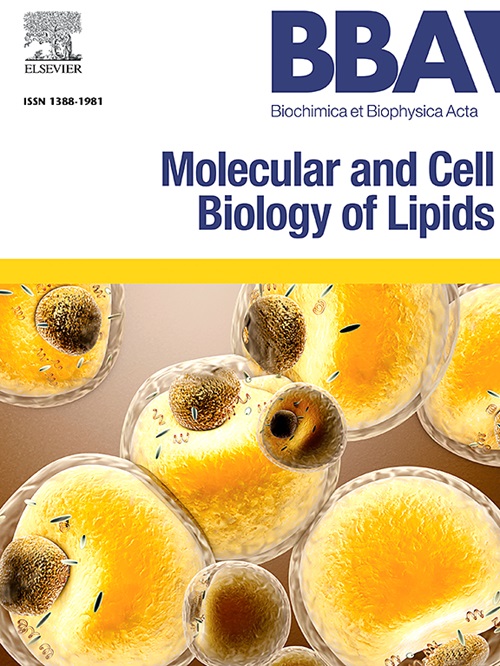Unveiling BCO2 function in macular pigment metabolism: Mitochondrial processing and expression in the primate retina
IF 3.3
2区 生物学
Q2 BIOCHEMISTRY & MOLECULAR BIOLOGY
Biochimica et biophysica acta. Molecular and cell biology of lipids
Pub Date : 2025-02-18
DOI:10.1016/j.bbalip.2025.159600
引用次数: 0
Abstract
BCO2 (β-carotene oxygenase 2) converts carotenoids into apocarotenoids by oxidative cleavage across double bonds and controls carotenoid homeostasis in vertebrate tissues. In this study, we examined BCO2's expression, localization, and activity in human cell lines and the retina. We generated peptide antibodies directed against primate BCO2 and validated their specificity using recombinant BCO1 (β-carotene oxygenase 1) and BCO2 proteins expressed in bacteria. The antibodies specifically detected human BCO2 by Western blot. In BCO2 expressing HepG2 cells, the antibodies recognized a 65 kDa mitochondrial protein that co-migrated with a recombinant truncated 522-amino-acid BCO2 variant, suggesting post-translational processing of the 579 amino acid long human BCO2 protein. Immunohistochemical analysis of macaque retina sections revealed BCO2 localization in the retinal pigment epithelium, photoreceptor inner segments, plexiform layer, and ganglion cell layer. Co-staining with COX IV indicated a mitochondrial localization of retinal BCO2 within photoreceptor inner segments. Western blot analysis of human donor retinas, separated into central and peripheral regions, identified higher BCO2 expression in the peripheral retina. Enzymatic activity assays demonstrated that BCO2 interacted with Aster proteins that transport carotenoids within cells. Our studies establish BCO2 as a mitochondrial protein expressed in the primate retina, where it likely plays a pivotal role in the metabolism of macular pigments and the maintenance of retinal health.

揭示BCO2在黄斑色素代谢中的功能:灵长类视网膜中的线粒体加工和表达
BCO2 (β-胡萝卜素加氧酶2)通过双键氧化裂解将类胡萝卜素转化为类胡萝卜素,并控制脊椎动物组织中类胡萝卜素的稳态。在这项研究中,我们检测了BCO2在人类细胞系和视网膜中的表达、定位和活性。我们制备了针对灵长类动物BCO2的肽抗体,并利用重组BCO1 (β-胡萝卜素加氧酶1)和细菌中表达的BCO2蛋白验证了它们的特异性。抗体通过Western blot特异性检测人BCO2。在表达BCO2的HepG2细胞中,抗体识别了一个65 kDa的线粒体蛋白,该蛋白与重组截断522个氨基酸的BCO2变体共迁移,表明579个氨基酸长的人BCO2蛋白在翻译后加工。猕猴视网膜切片免疫组化分析显示BCO2定位于视网膜色素上皮、光感受器内节段、丛状层和神经节细胞层。COX IV共染色显示视网膜BCO2在感光器内段的线粒体定位。Western blot分析将人供体视网膜分为中央和外周区域,发现外周视网膜中BCO2表达较高。酶活性分析表明,BCO2与细胞内运输类胡萝卜素的Aster蛋白相互作用。我们的研究证实BCO2是灵长类视网膜中表达的一种线粒体蛋白,它可能在黄斑色素的代谢和视网膜健康的维持中起着关键作用。
本文章由计算机程序翻译,如有差异,请以英文原文为准。
求助全文
约1分钟内获得全文
求助全文
来源期刊
CiteScore
11.00
自引率
2.10%
发文量
109
审稿时长
53 days
期刊介绍:
BBA Molecular and Cell Biology of Lipids publishes papers on original research dealing with novel aspects of molecular genetics related to the lipidome, the biosynthesis of lipids, the role of lipids in cells and whole organisms, the regulation of lipid metabolism and function, and lipidomics in all organisms. Manuscripts should significantly advance the understanding of the molecular mechanisms underlying biological processes in which lipids are involved. Papers detailing novel methodology must report significant biochemical, molecular, or functional insight in the area of lipids.

 求助内容:
求助内容: 应助结果提醒方式:
应助结果提醒方式:


